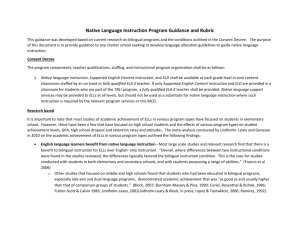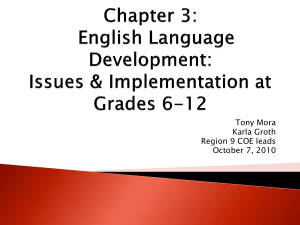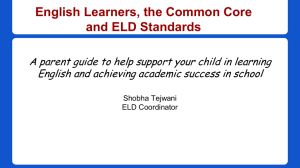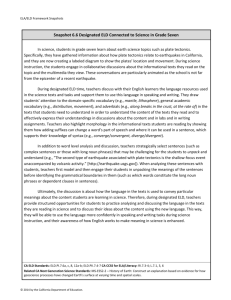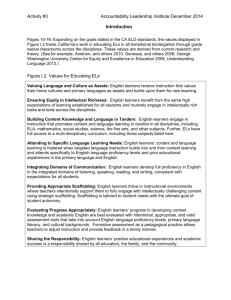ELA: Native Language Supports Rubric and Guidelines
advertisement
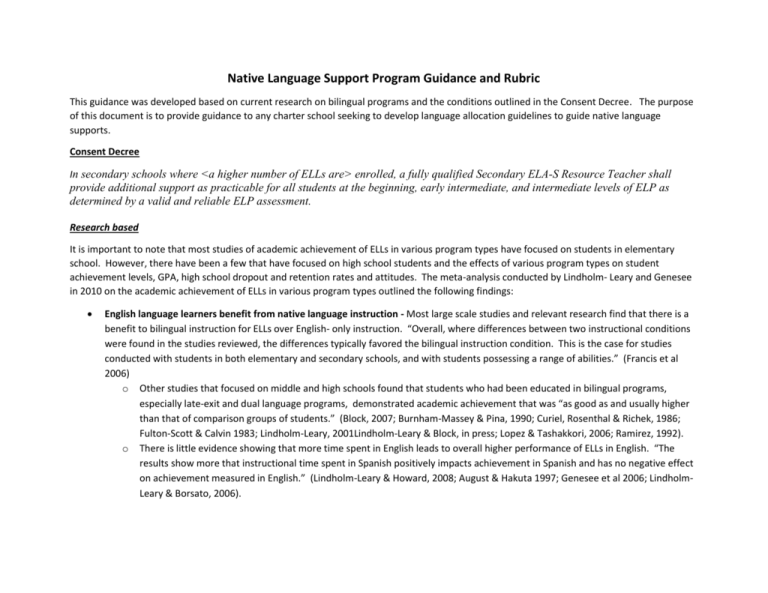
Native Language Support Program Guidance and Rubric This guidance was developed based on current research on bilingual programs and the conditions outlined in the Consent Decree. The purpose of this document is to provide guidance to any charter school seeking to develop language allocation guidelines to guide native language supports. Consent Decree In secondary schools where <a higher number of ELLs are> enrolled, a fully qualified Secondary ELA-S Resource Teacher shall provide additional support as practicable for all students at the beginning, early intermediate, and intermediate levels of ELP as determined by a valid and reliable ELP assessment. Research based It is important to note that most studies of academic achievement of ELLs in various program types have focused on students in elementary school. However, there have been a few that have focused on high school students and the effects of various program types on student achievement levels, GPA, high school dropout and retention rates and attitudes. The meta-analysis conducted by Lindholm- Leary and Genesee in 2010 on the academic achievement of ELLs in various program types outlined the following findings: English language learners benefit from native language instruction - Most large scale studies and relevant research find that there is a benefit to bilingual instruction for ELLs over English- only instruction. “Overall, where differences between two instructional conditions were found in the studies reviewed, the differences typically favored the bilingual instruction condition. This is the case for studies conducted with students in both elementary and secondary schools, and with students possessing a range of abilities.” (Francis et al 2006) o Other studies that focused on middle and high schools found that students who had been educated in bilingual programs, especially late-exit and dual language programs, demonstrated academic achievement that was “as good as and usually higher than that of comparison groups of students.” (Block, 2007; Burnham-Massey & Pina, 1990; Curiel, Rosenthal & Richek, 1986; Fulton-Scott & Calvin 1983; Lindholm-Leary, 2001Lindholm-Leary & Block, in press; Lopez & Tashakkori, 2006; Ramirez, 1992). o There is little evidence showing that more time spent in English leads to overall higher performance of ELLs in English. “The results show more that instructional time spent in Spanish positively impacts achievement in Spanish and has no negative effect on achievement measured in English.” (Lindholm-Leary & Howard, 2008; August & Hakuta 1997; Genesee et al 2006; LindholmLeary & Borsato, 2006). There is no “one best model” – Context matters - The authors of the meta-analysis highlight that there is “no one best model that will serve all English Learners at all times.” It is important to consider the “community context, the needs of the students to be served and the resources that are available for implementing the program.” Reference: Lindholm-Leary, K. & Genesee, F. (2010). “Alternative Educational Programs for English Learners.” Improving Education for English Learners: Research- Based Approaches. California Department of Education: Sacramento. Guidelines for Developing Native Language Support Plan and Guidelines Content taught in English English Language Development (ELD) Minimum of 45 Minute class for ELs Language Arts Entering Level 1-1.9 Emerging/ Developing Level 2-3.5 Developing/ Expanding/ Bridging Level 3.6-4.9 English Instruction specifically targeted for ELs English Instruction specifically targeted for ELs English Instruction specifically targeted for ELs Supported English Content Instruction with ELD. Native language supports provided by a fully qualified ELA-S Resource teacher. Supported English Content Instruction with ELD. Native language supports provided by a fully qualified ELA-S Resource teacher. Supported English Content Instruction with ELD. Supported English Content Instruction with ELD. Native language supports provided as needed. Students may choose at least one Academic Elective in Spanish Students may choose at least one Academic Elective in Spanish Core Content: Mathematics, Social Studies and Science Native Language supports provided for all students at the beginning, early intermediate, and intermediate levels of ELP Academic Electives: Students may choose at Spanish least one Academic Elective AP Spanish in Spanish Heritage Language Other . Program Design Comments REQUIRED: The native language support model is grounded in clearly articulated language allocation guidelines* that indicate when students will receive native language supports, Sheltered content instruction in English and English Language Development (ELD) as a part of their school day. *Refer to the guidance on language allocation guidelines above. REQUIRED: The native language support model is organized to promote second language acquisition using cognitively demanding and grade-level appropriate content. REQUIRED: The program design includes a stand-alone ELD block daily for all English Learners, regardless of ELP level. The ELD block should last a minimum of 45 minutes, be taught by an ELA qualified teacher and utilizes a research based ELD curriculum. REQUIRED: The program describes the use of annual performance objectives, activities, timeframes, language(s), grade(s), performance standards that are tied to the language allocation guidelines. REQUIRED: The school leadership communicates the language allocation guidelines with appropriate stakeholders including new and returning families. Assessment and Accountability Comments REQUIRED: Student assessment data, including language proficiency data, is used to make educational programming decisions. REQUIRED: The language of assessment is aligned to the language of instruction. REQUIRED: Student assessment is aligned to the content and language standards and is used for evaluation of the program and instruction. RECOMMENDED: The school leadership uses multiple data measures for program accountability and evaluation. Curriculum and Resources/ Materials Comments REQUIRED: Standards based curriculums are used to support all content areas and the language allocation guidelines. Spanish resources and materials are provided for students in need of native language supports in the core content areas. REQUIRED: Resources are distributed equitably within the program and the school to support native s, Sheltered English and ELD instruction. RECOMMENDED: Scope and Sequence documents and/ or unit maps are used to outline how and when native language supports will be utilized. RECOMMENDED: Classroom libraries are available in both English and Spanish for the ELA-S classrooms. Instruction Comments REQUIRED: Native language support is provided in core content classrooms focused on the concepts requiring heavy lifting. RECOMMENDED: Teachers use a variety of cues (visual, color-coding, etc.) to clearly indicate how and when instruction will occur in Spanish, in English or in a bilingual metalinguistic space. RECOMMENDED: A variety of supports (sensory, visual and grouping) are utilized in all content areas and classrooms for English learners. RECOMMENDED: Differentiation for students of varying language abilities is evident both at the program level and the classroom level. Staff Recruiting and Retention Comments REQUIRED: A staffing structure and recruitment plan that includes: A Spanish-speaking teacher (i.e., ELA-S) who will provide additional supports for students whose English Language proficiency is intermediate level or below Spanish-speaking paraprofessionals to provide native language supports A trained and bilingual counselor/designee for postsecondary readiness Spanish-speaking office staff REQUIRED: A trained school leader who oversees and evaluates the effectiveness of ELA services provided by the school teachers Professional Development Comments REQUIRED: The school has a professional development plan to ensure that all staff members are trained on the language allocation guidelines and its implementation. REQUIRED (Charter schools): The school has a designated trainer who will train staff on the ELA modules as a part of the ELA Qualification Training channel to ensure that all teachers gain their ELA qualification within two school years. RECOMMENDED: The principal attends professional development focused on English Learners. RECOMMENDED: The professional development plan is aligned to the UIP. Family and Community Comments REQUIRED (District run schools): The school has an effective PAC (Parent Advisory Committee) that is comprised of families of students receiving ELA program services that meets at least four-times per year. Provide the opportunity for PAC representatives to participate in the monthly ELA District Advisory Committee (DAC) meetings. REQUIRED (Charter schools): The school has an effective SAC or similar structure that meets statutory requirements, includes families of students receiving ELA program services, and monitors ELA programming in the school. REQUIRED: The school has a responsive infrastructure for positive, active, and ongoing relations with students’ families and the community in their home language. REQUIRED: The school has a process for articulating the Language Allocation Guidelines with prospective, new and returning families. RECOMMENDED: The program views and involves parents and community members as strategic partners. Implementation Plan (year 0-3) Comments REQUIRED: The principal will create a hiring plan for years 0-3 to ensure adequate staffing and its oversight and appropriately reflects staffing and other expenses associated with providing native language support, Sheltered English and ELD instruction. REQUIRED: Budget is created for years 0-5 RECOMMENDED: Professional Development Plan is developed for years 0-3 RECOMMENDED: There is a coordinated plan for supporting English Learners. RECOMMENDED: There is a coordinated plan for promoting crosscultural competence.
